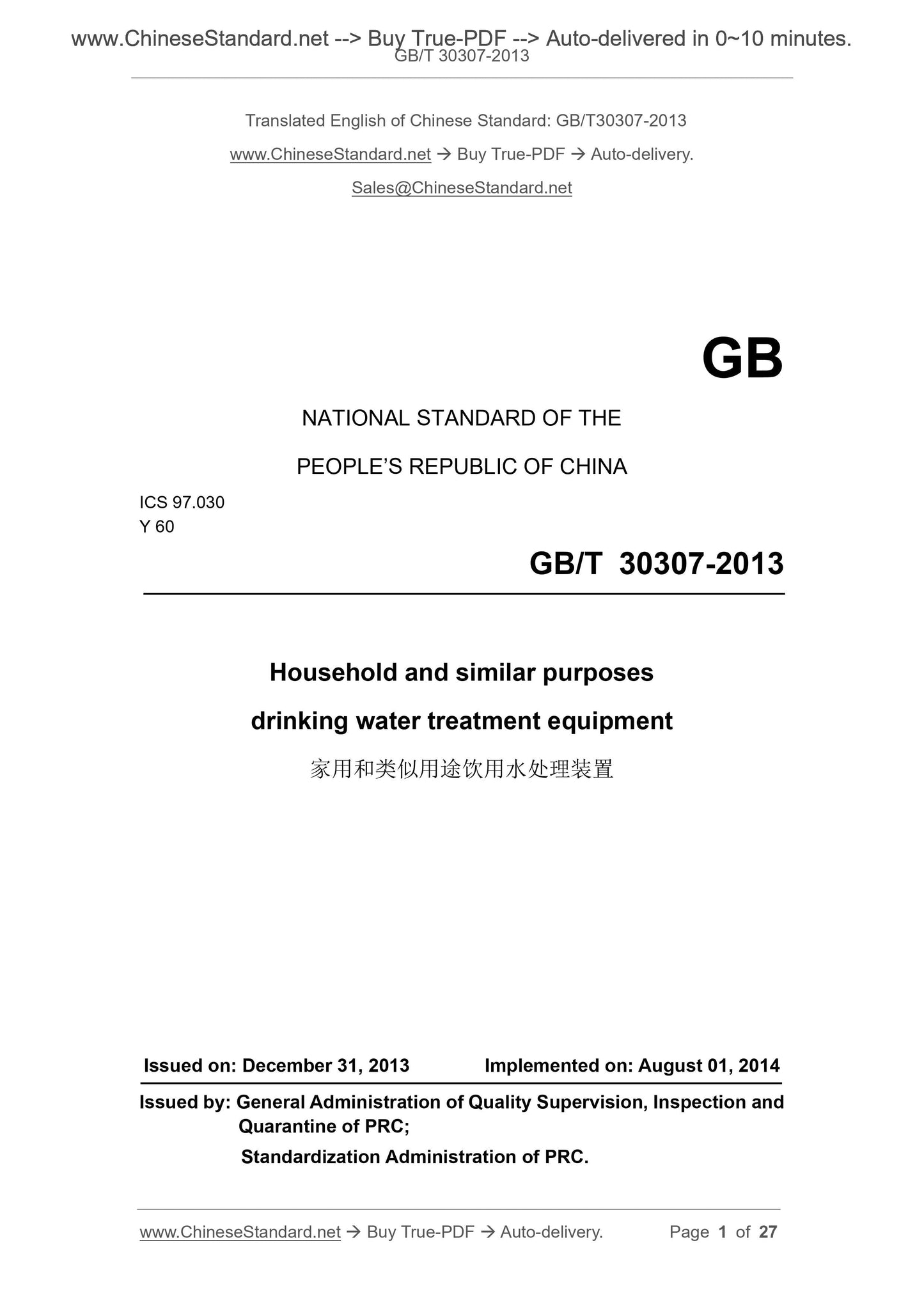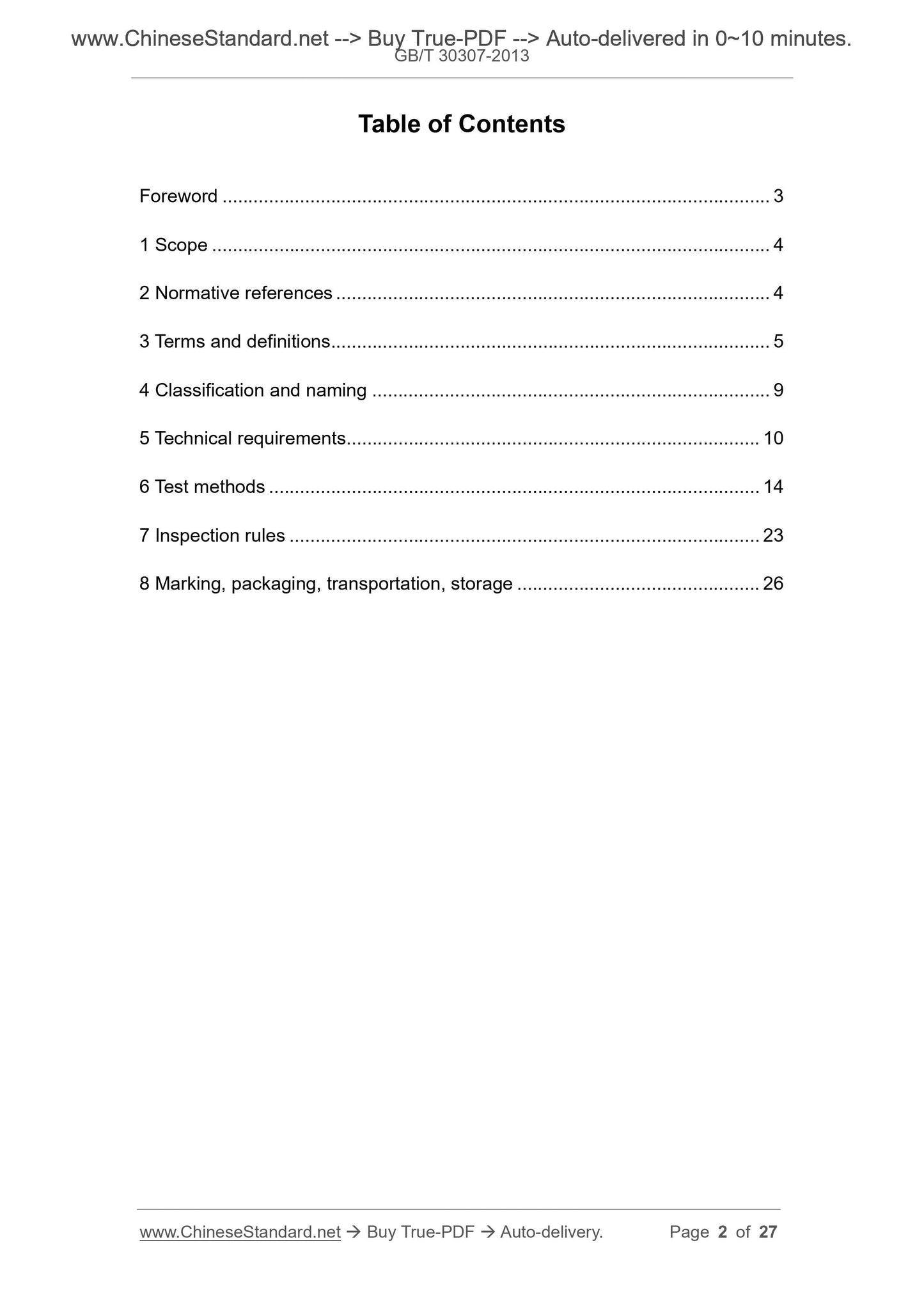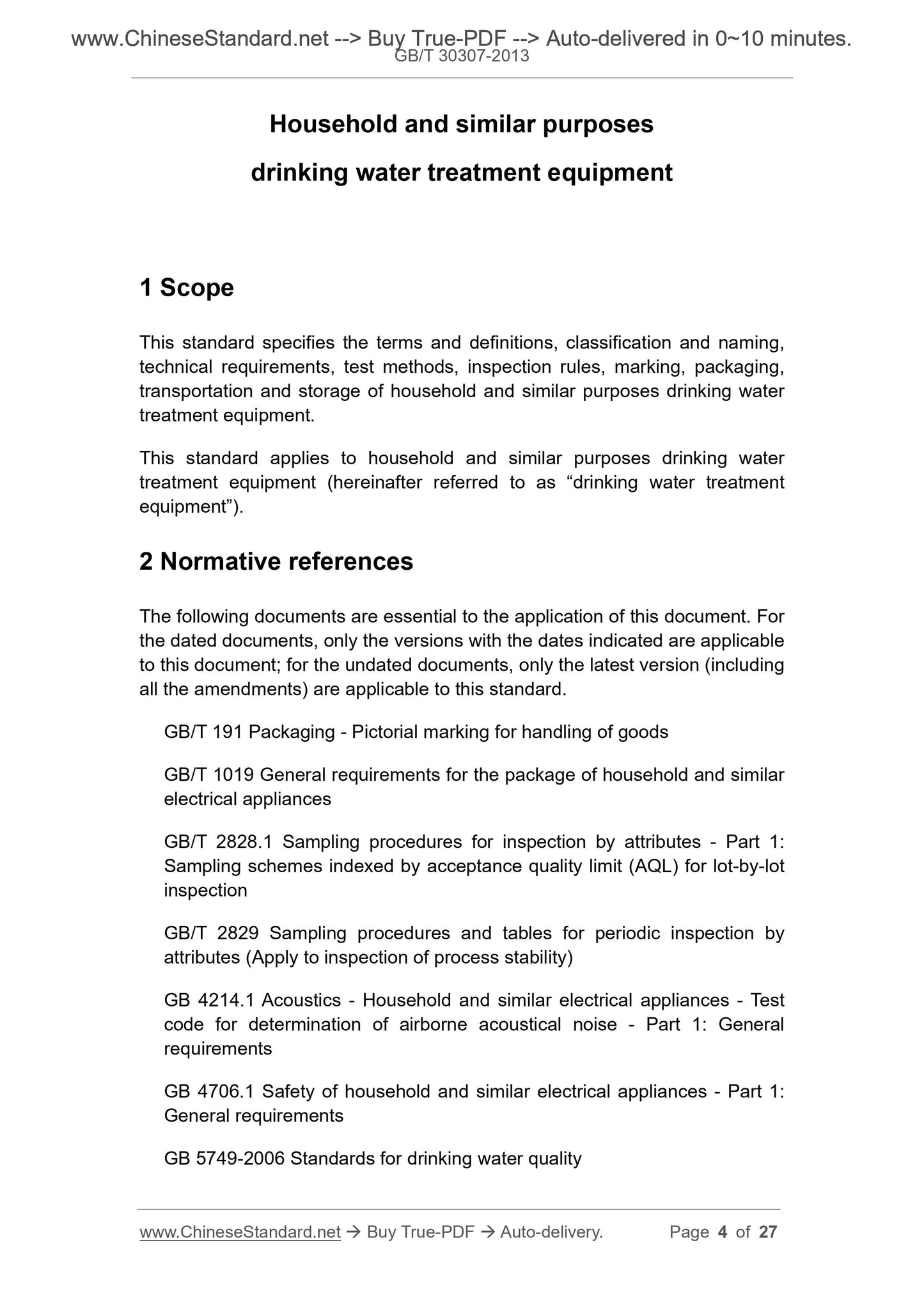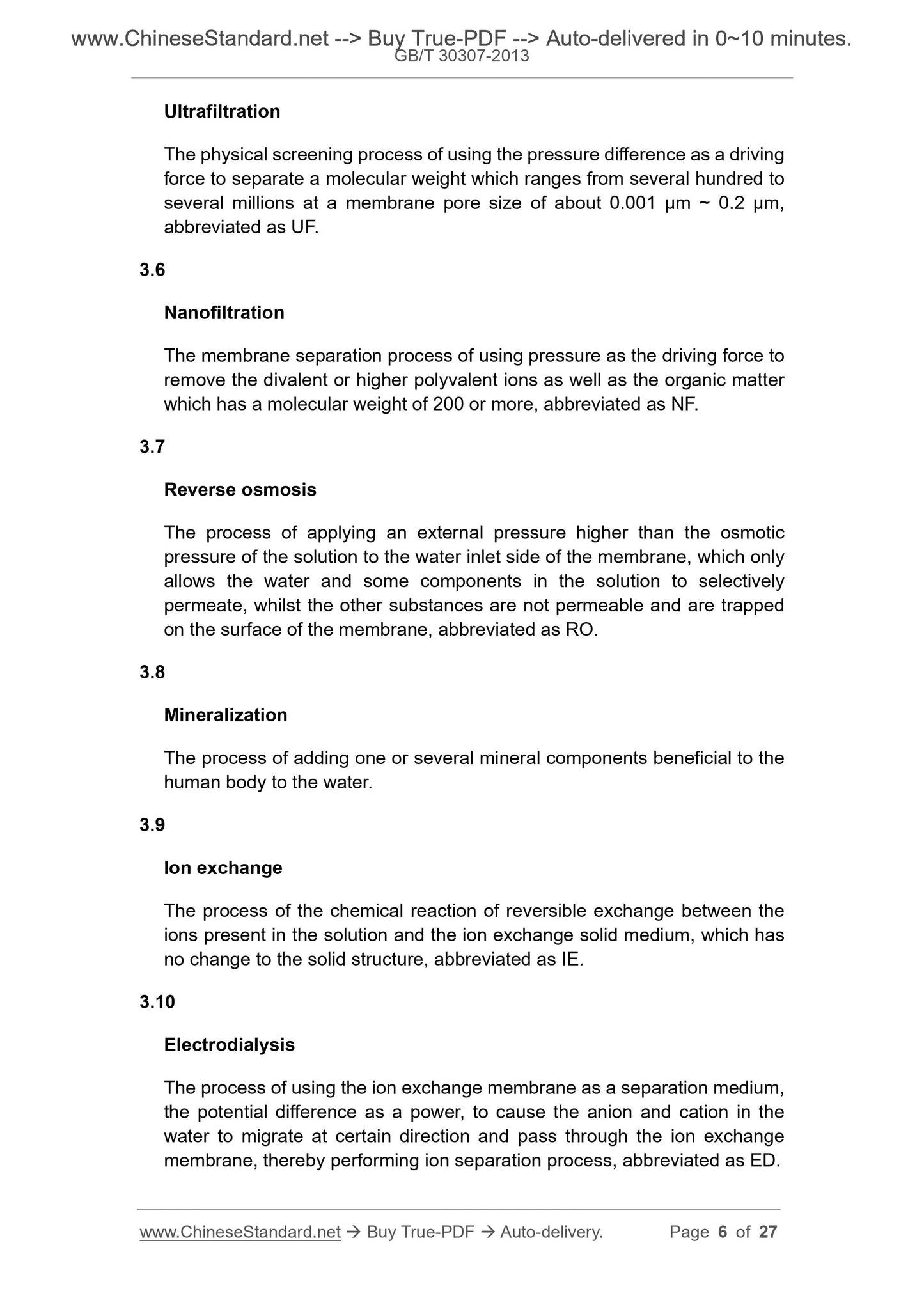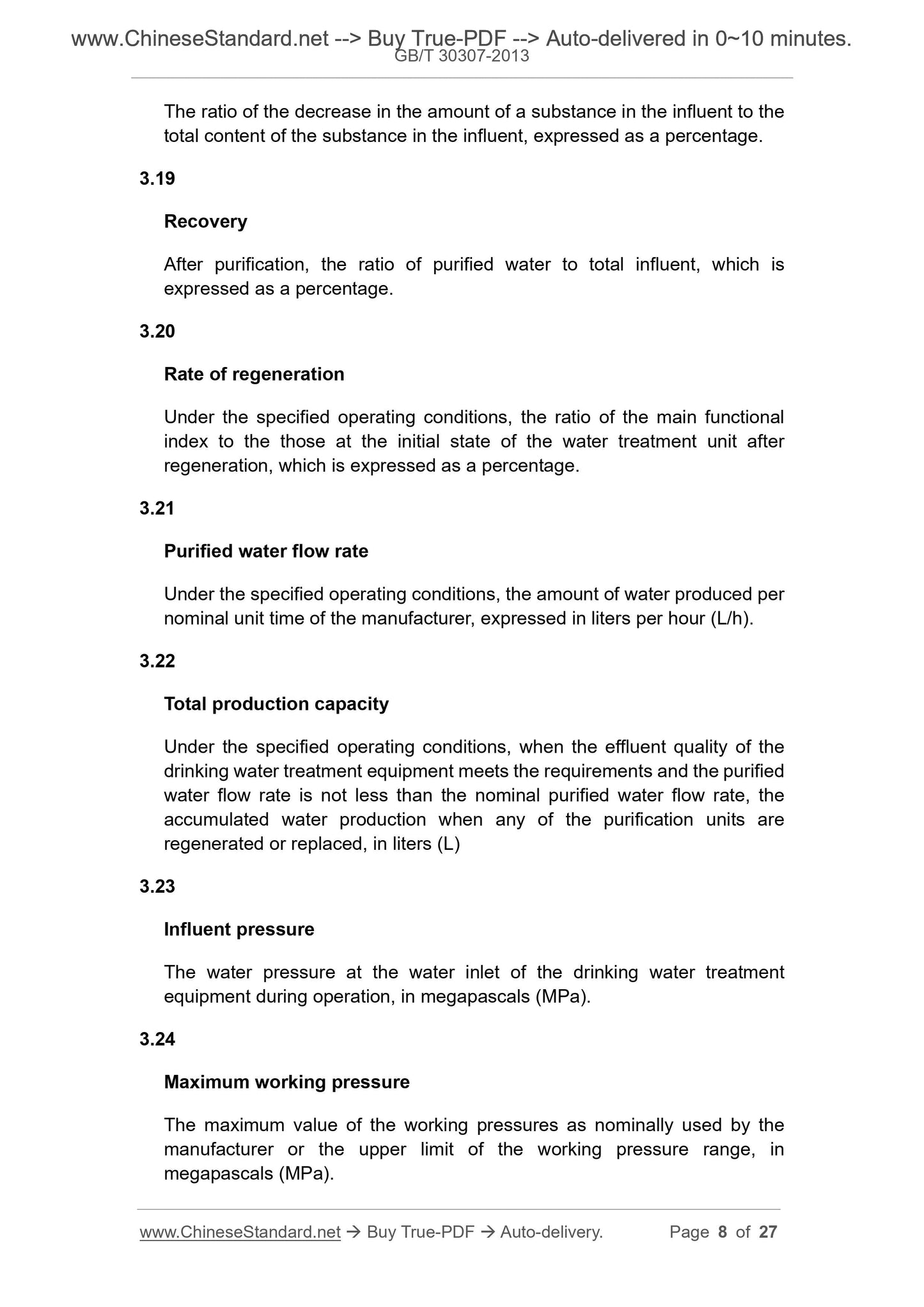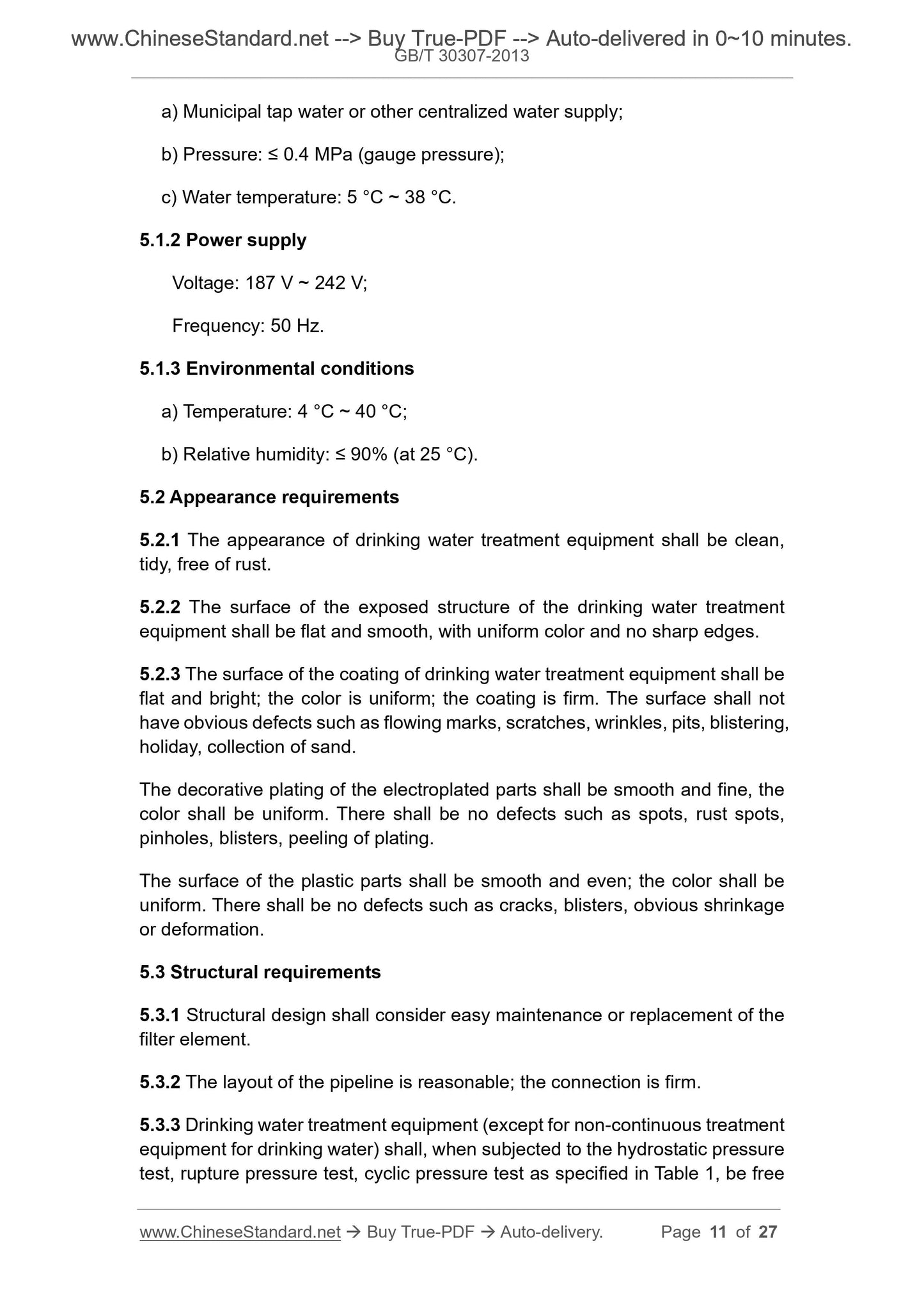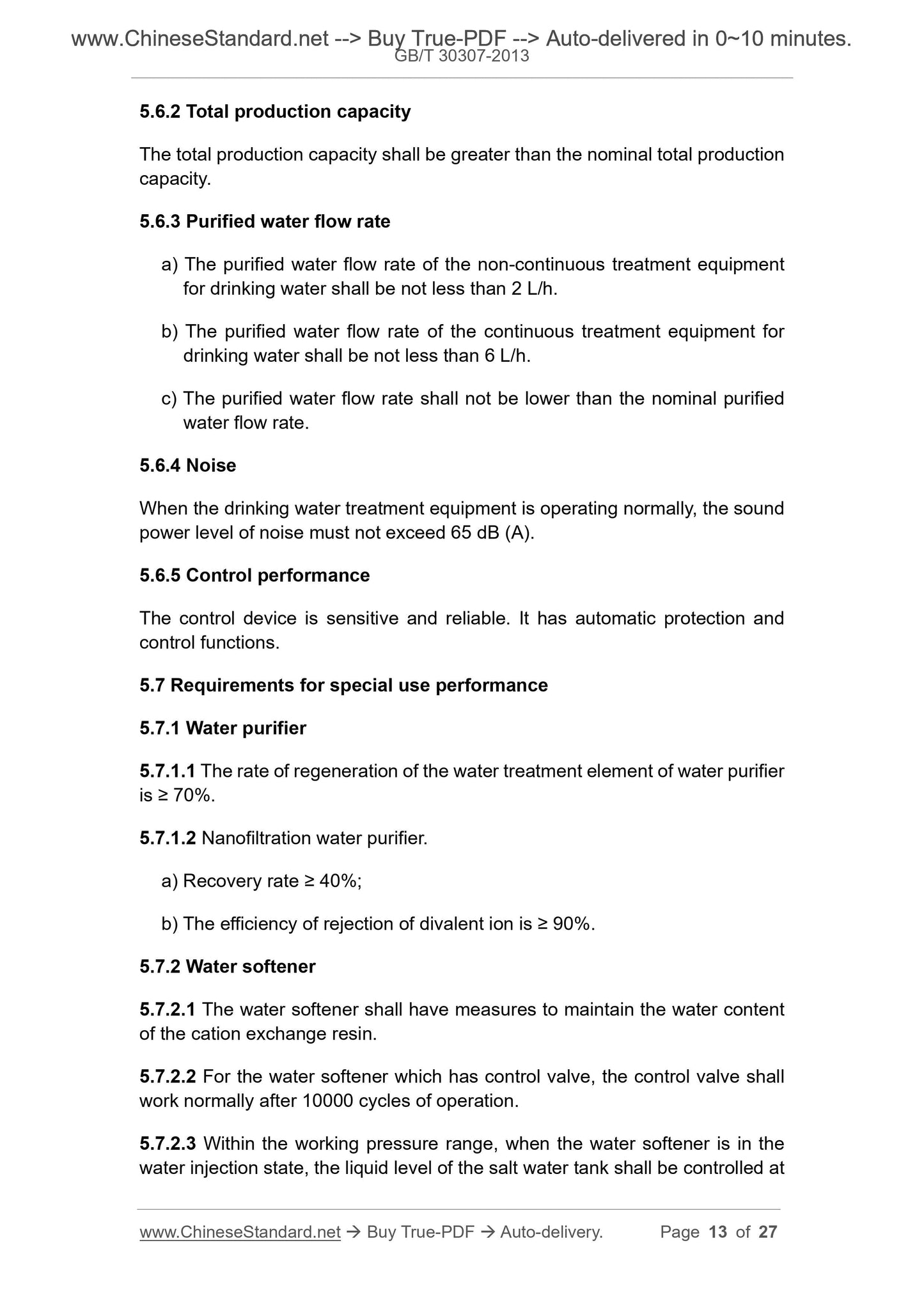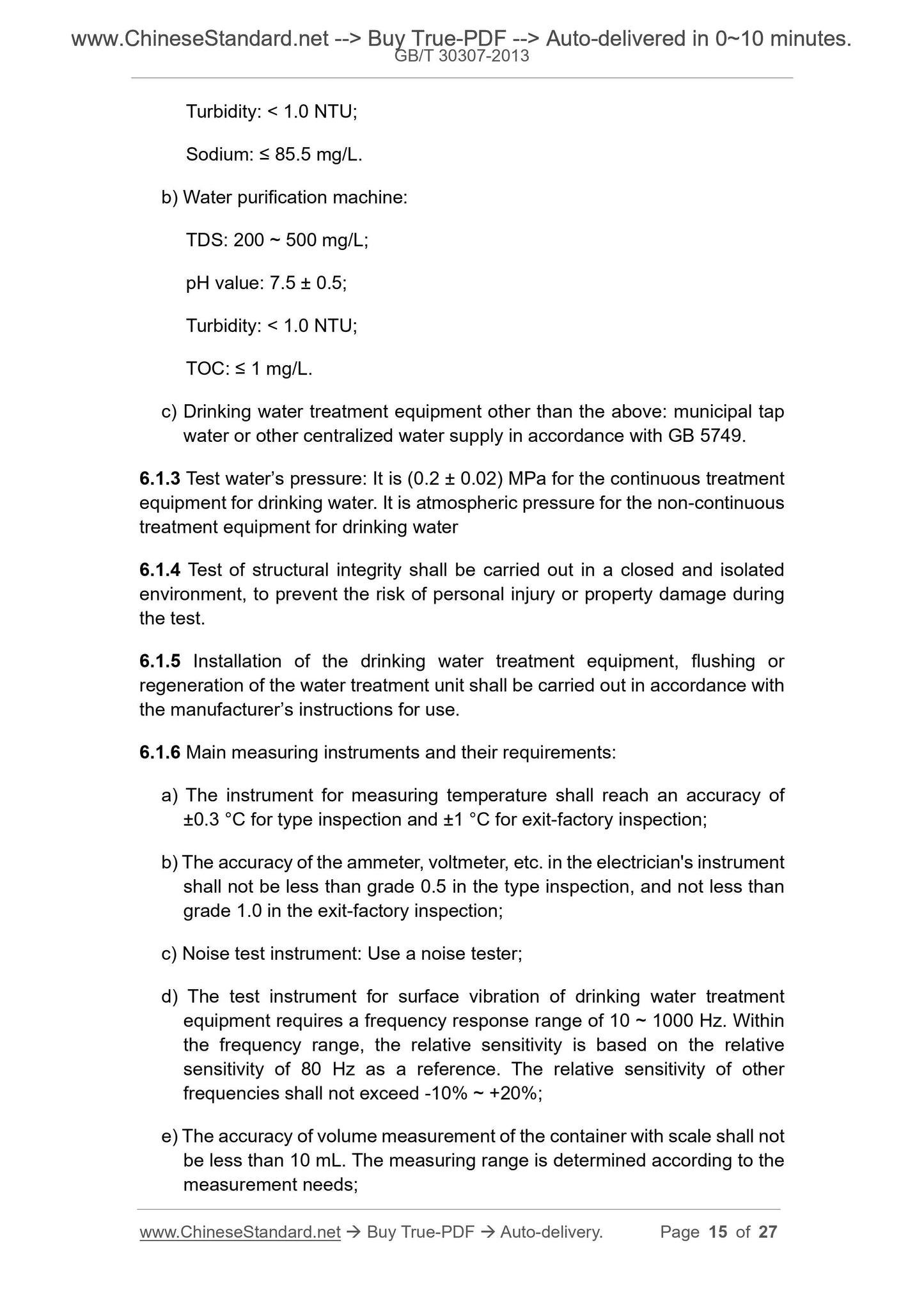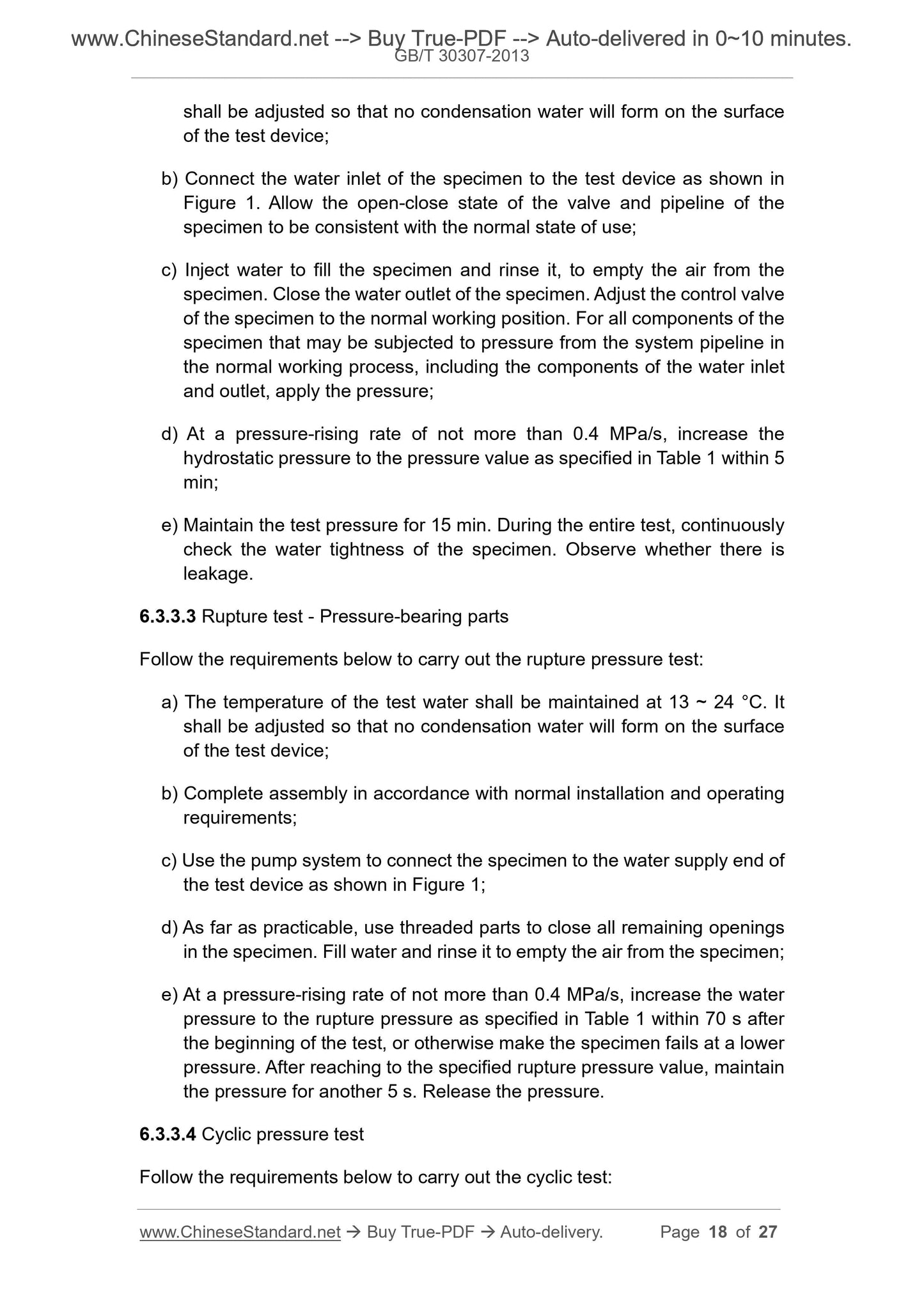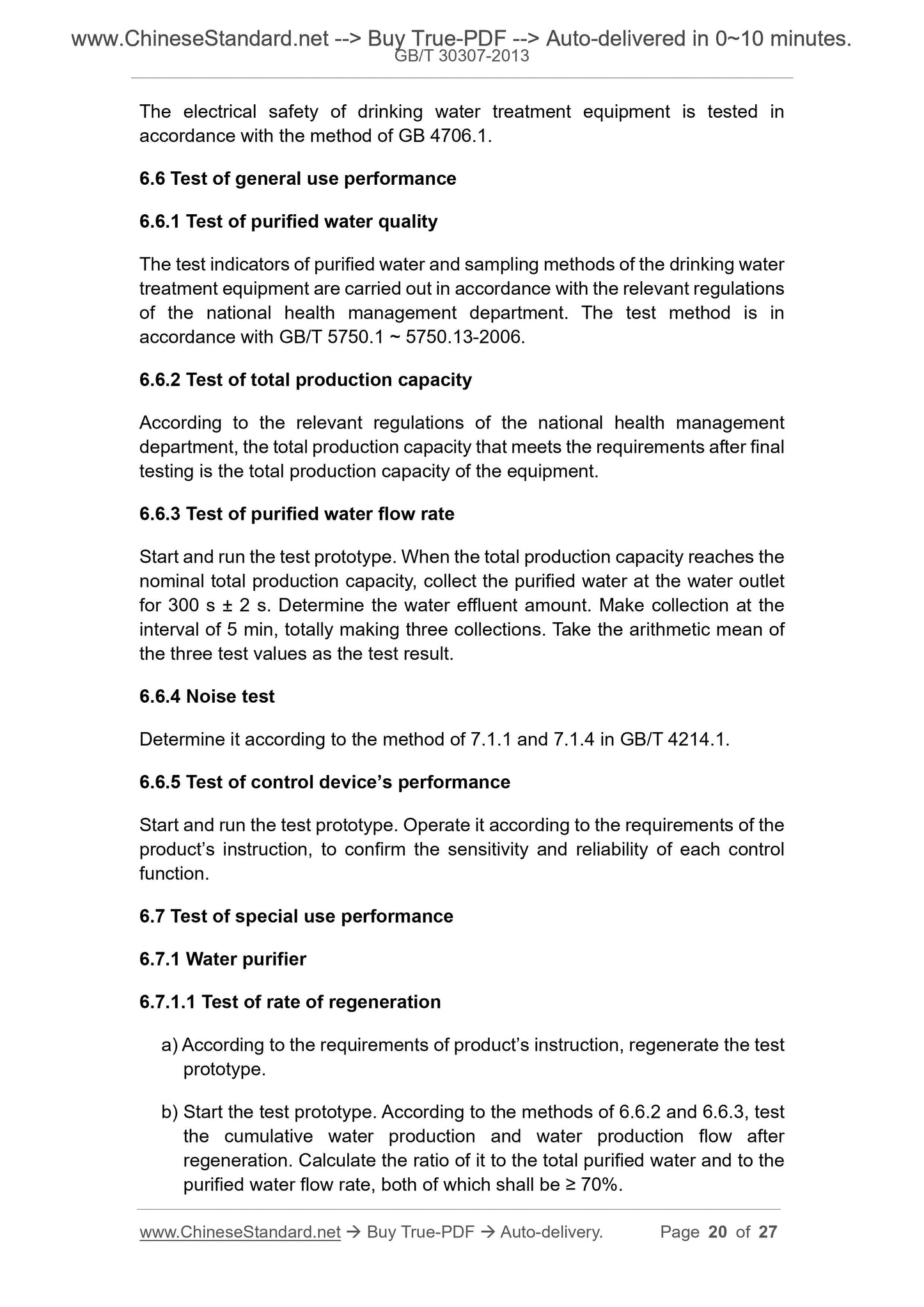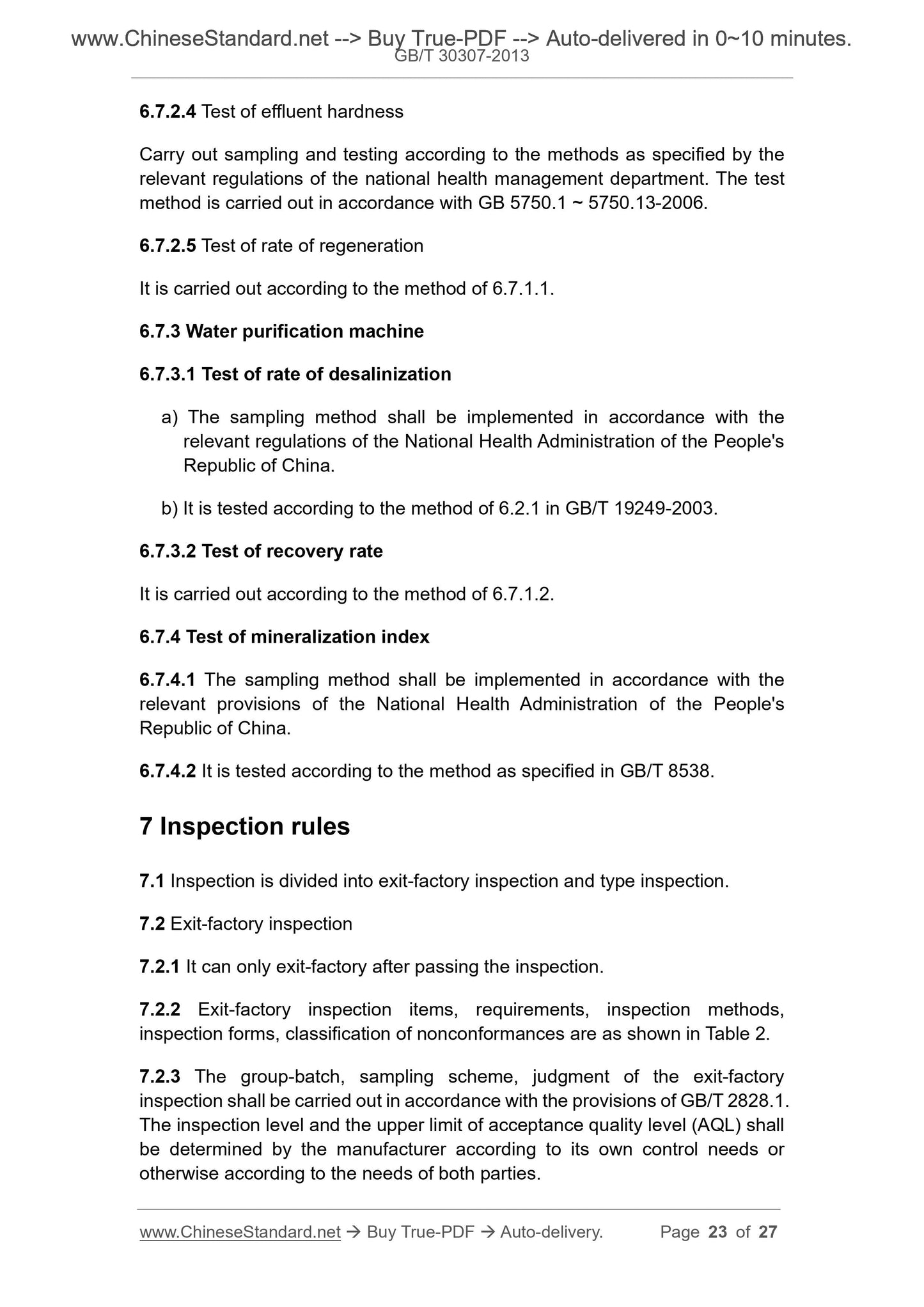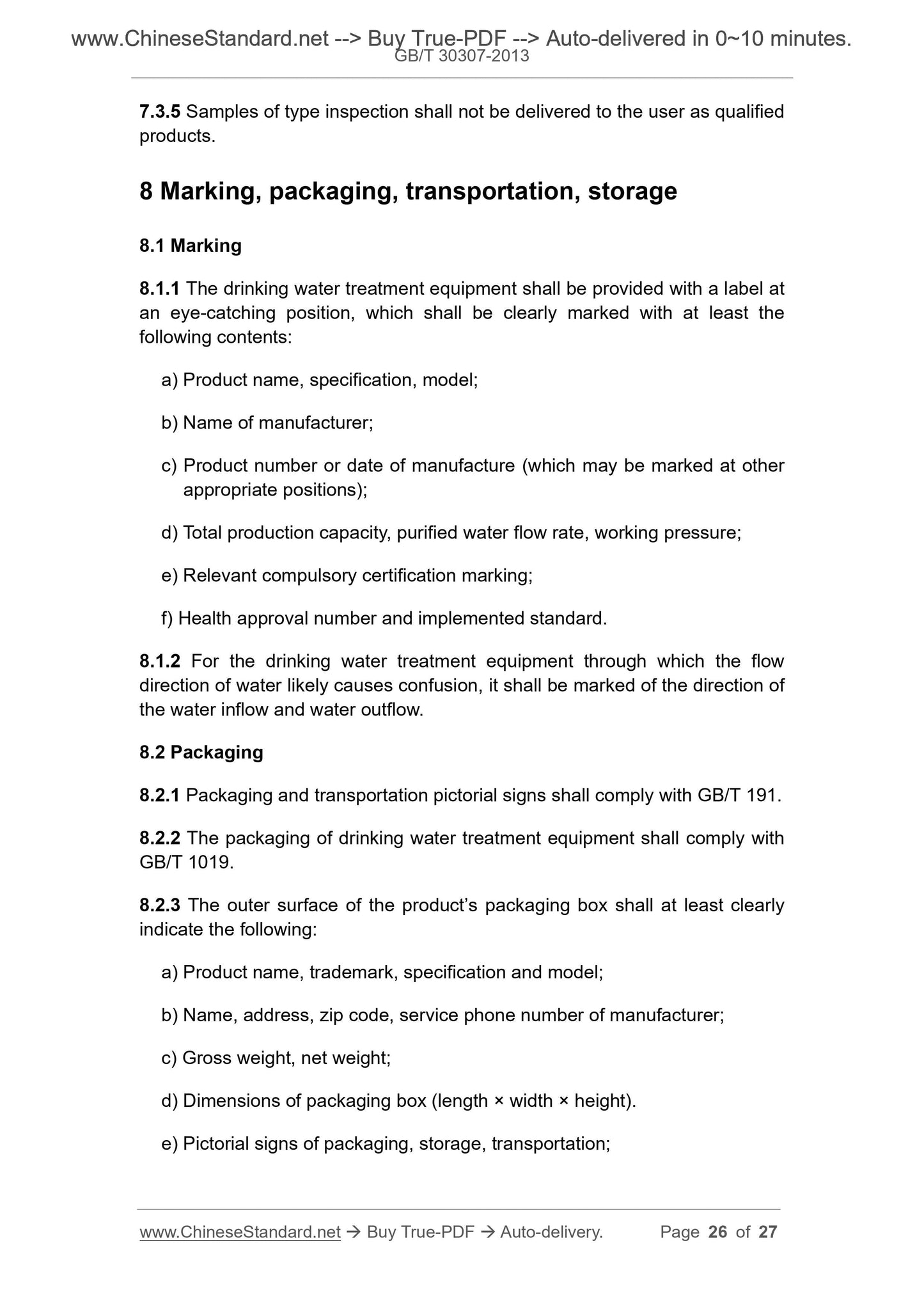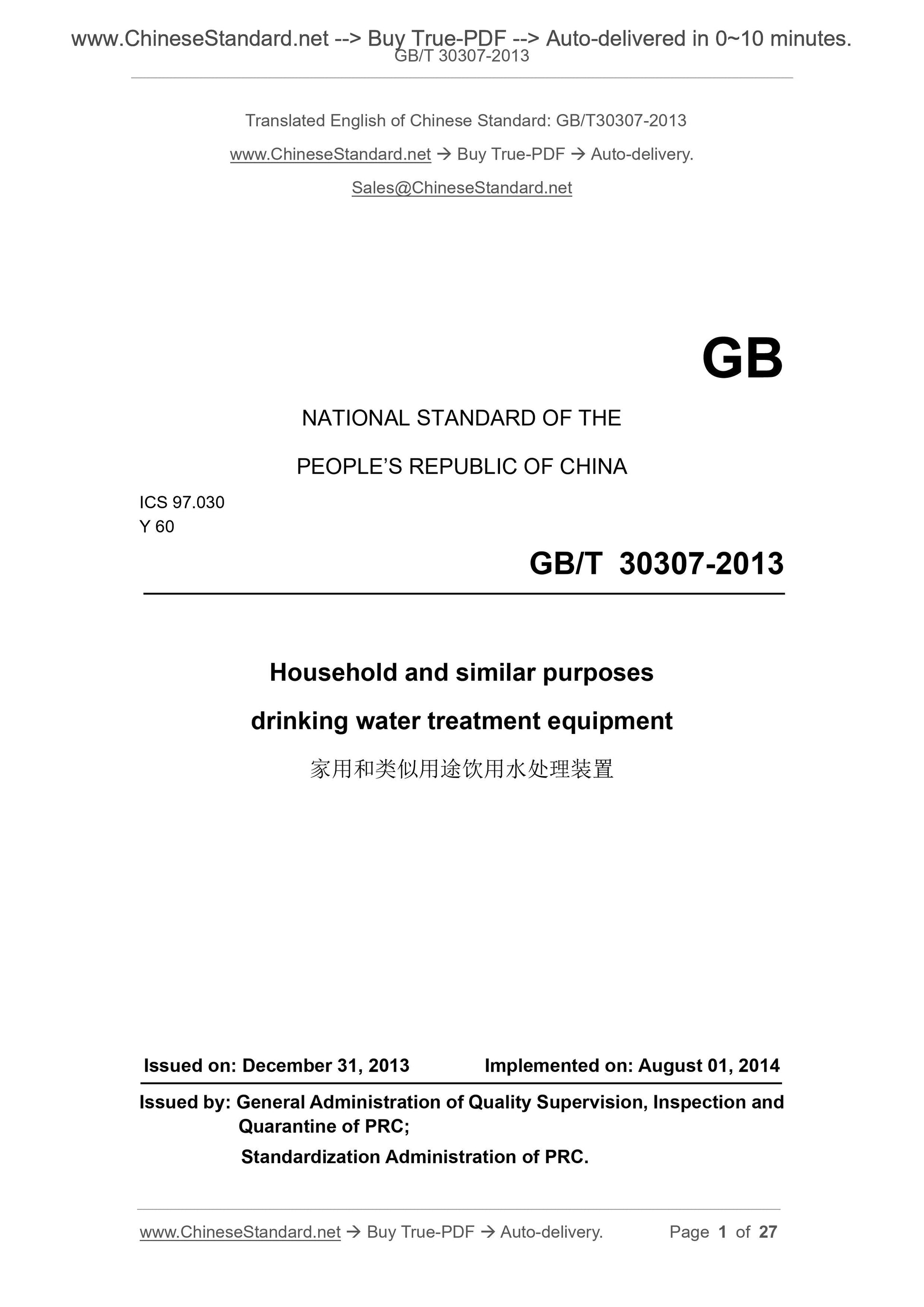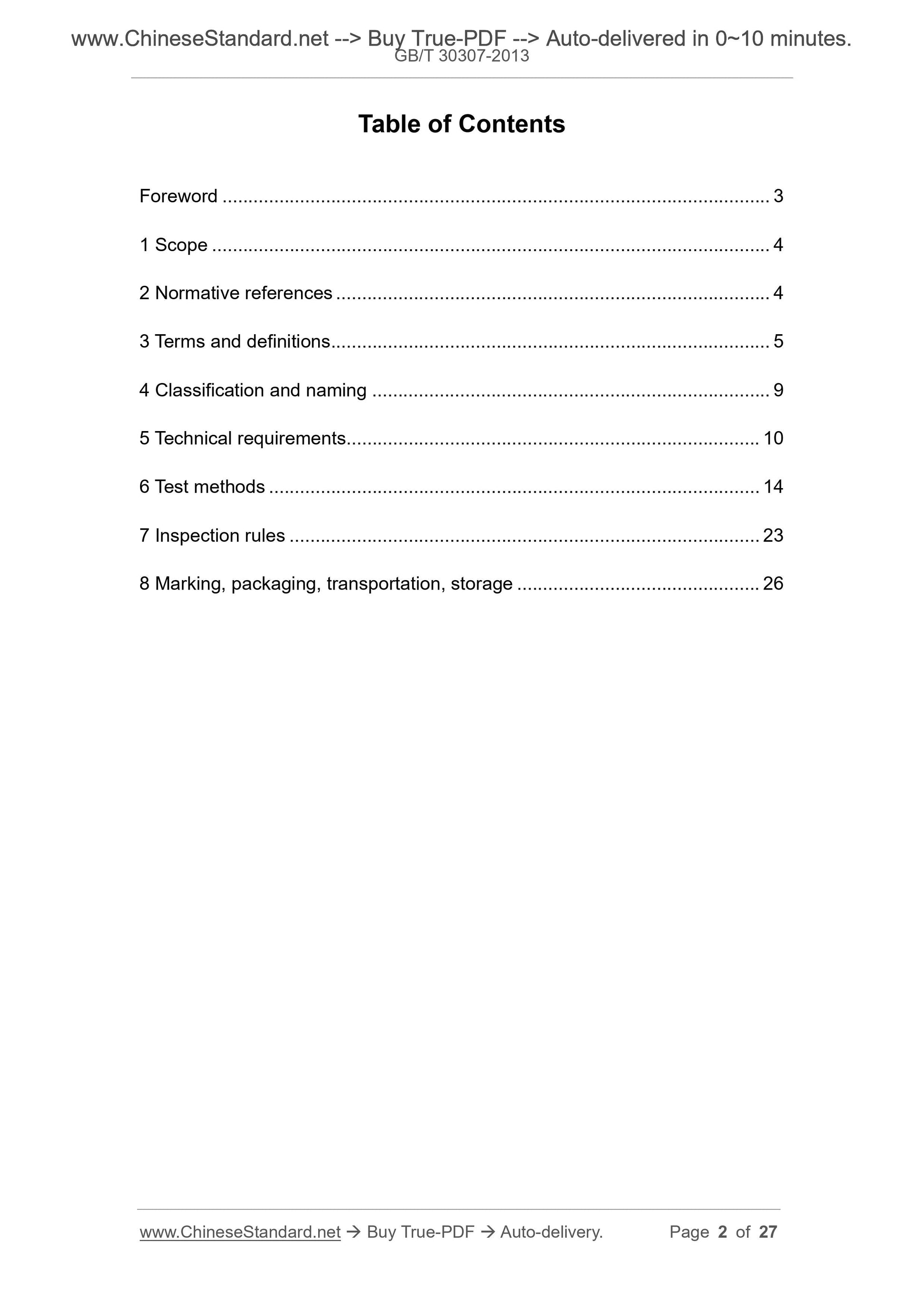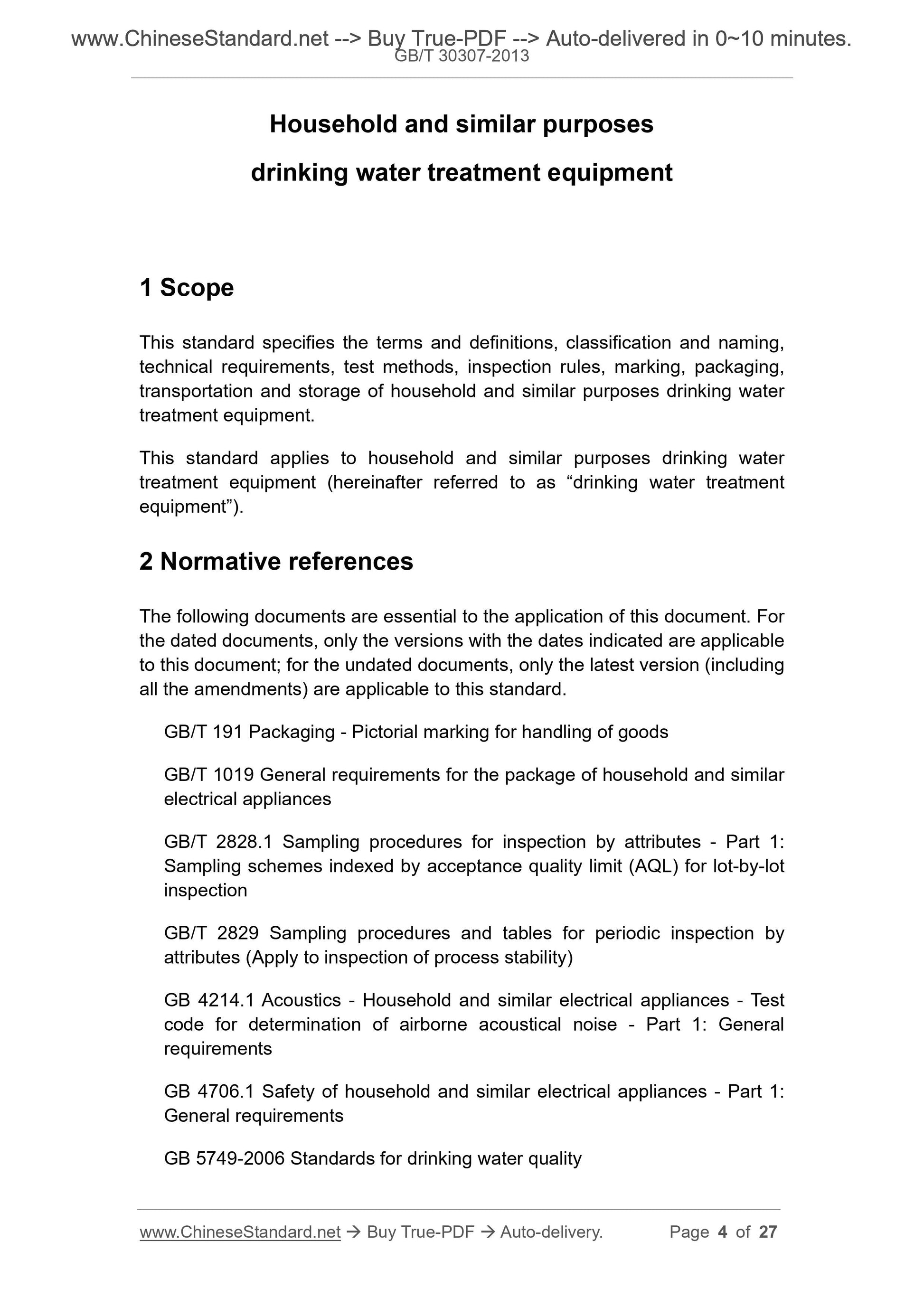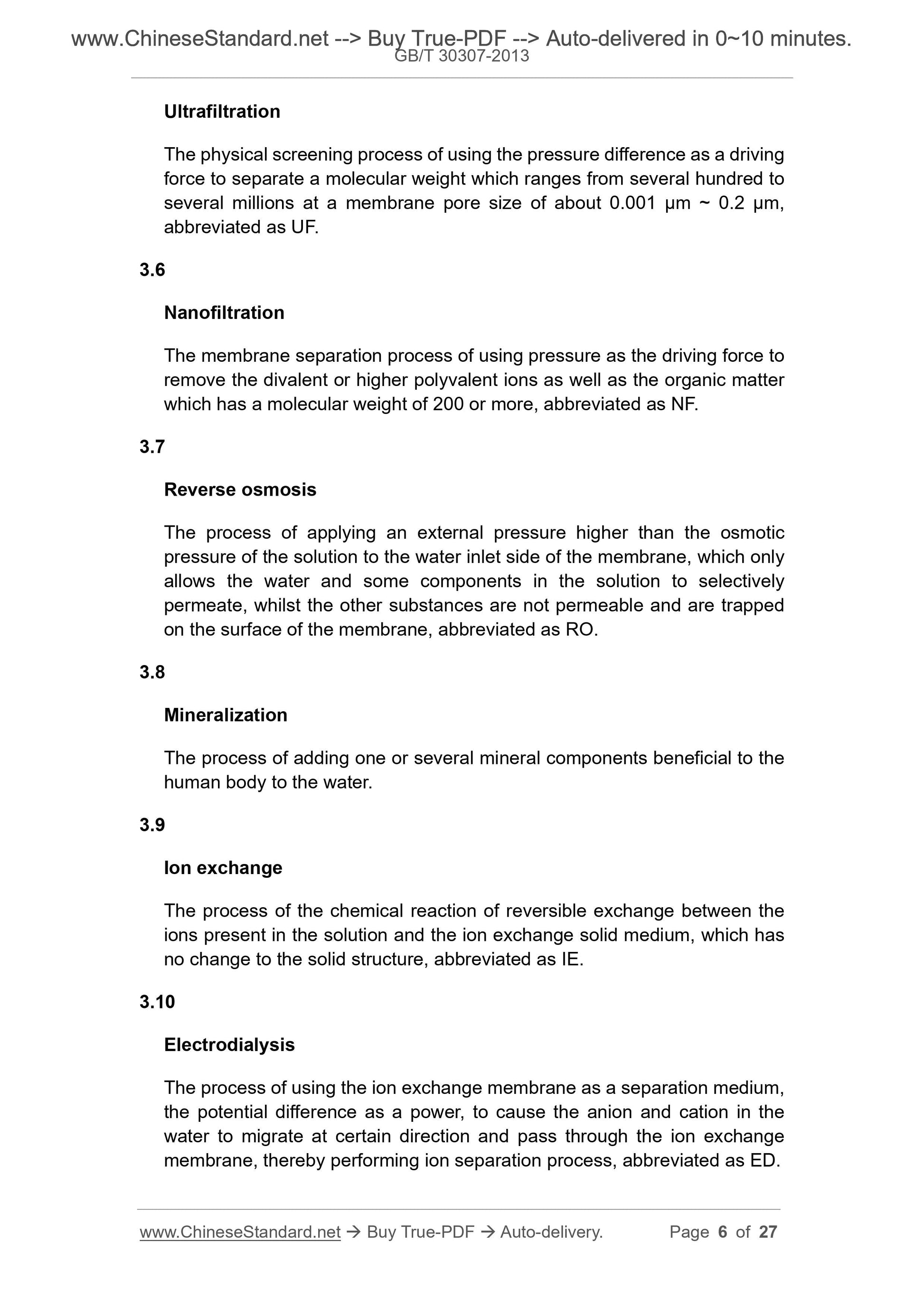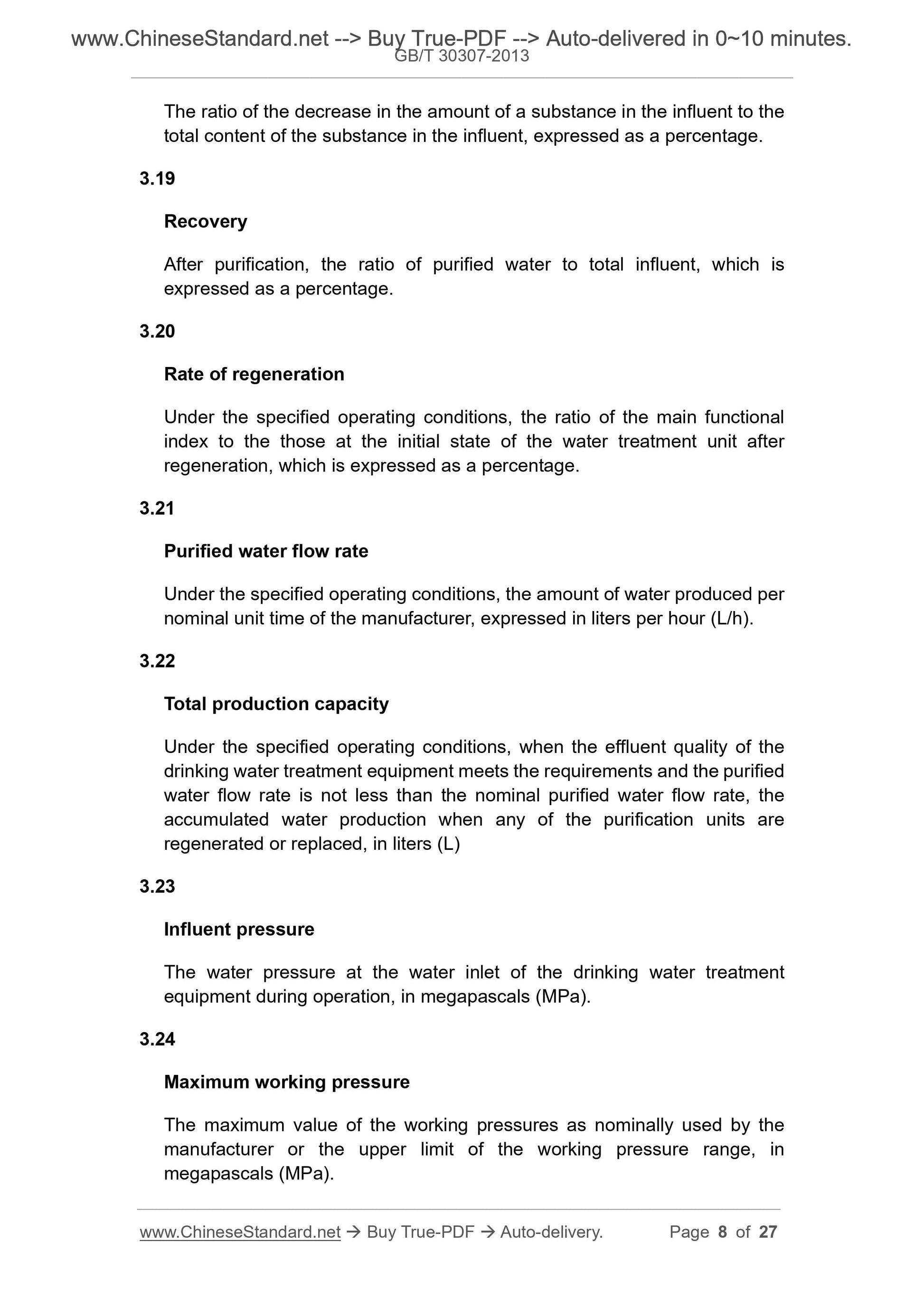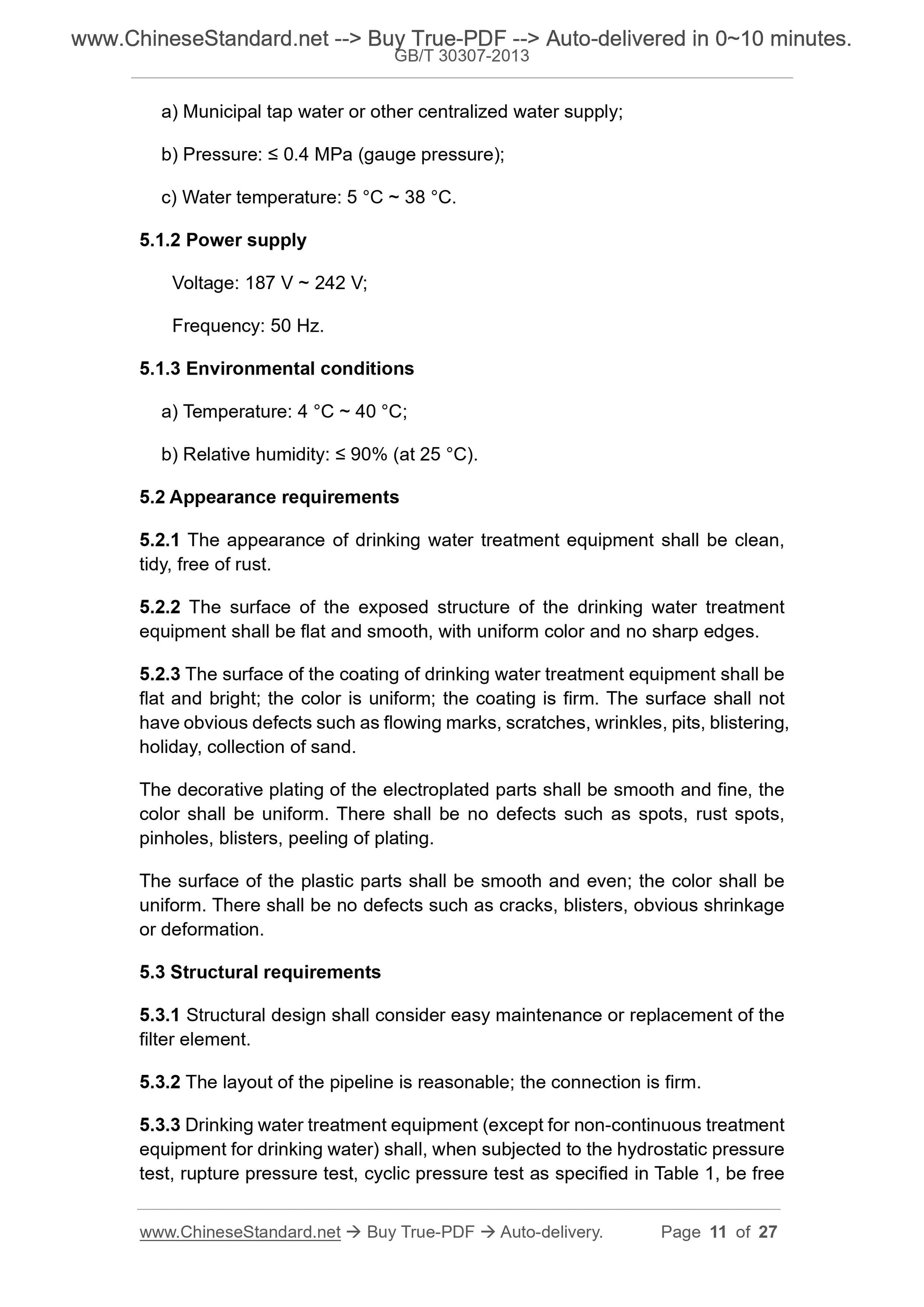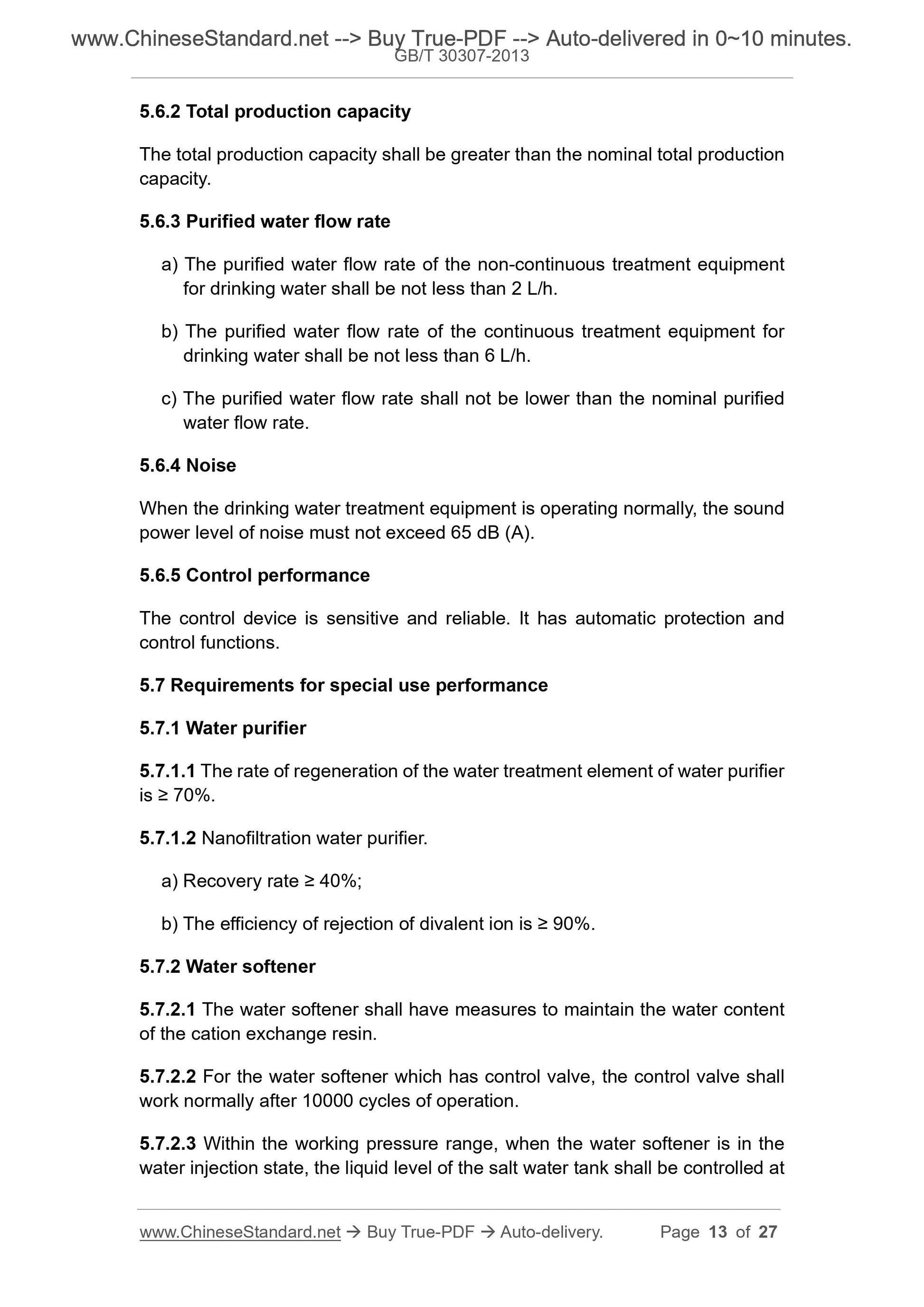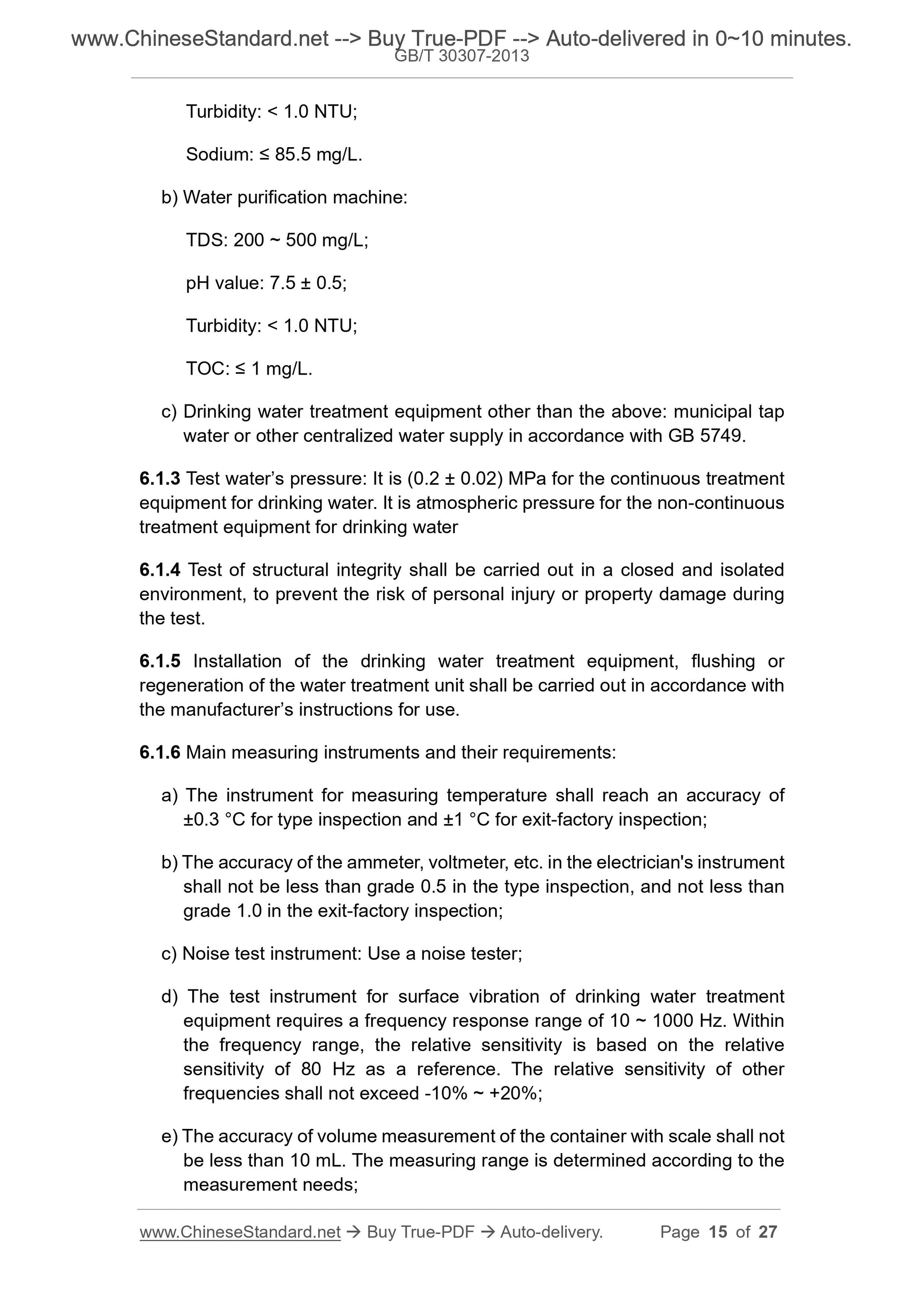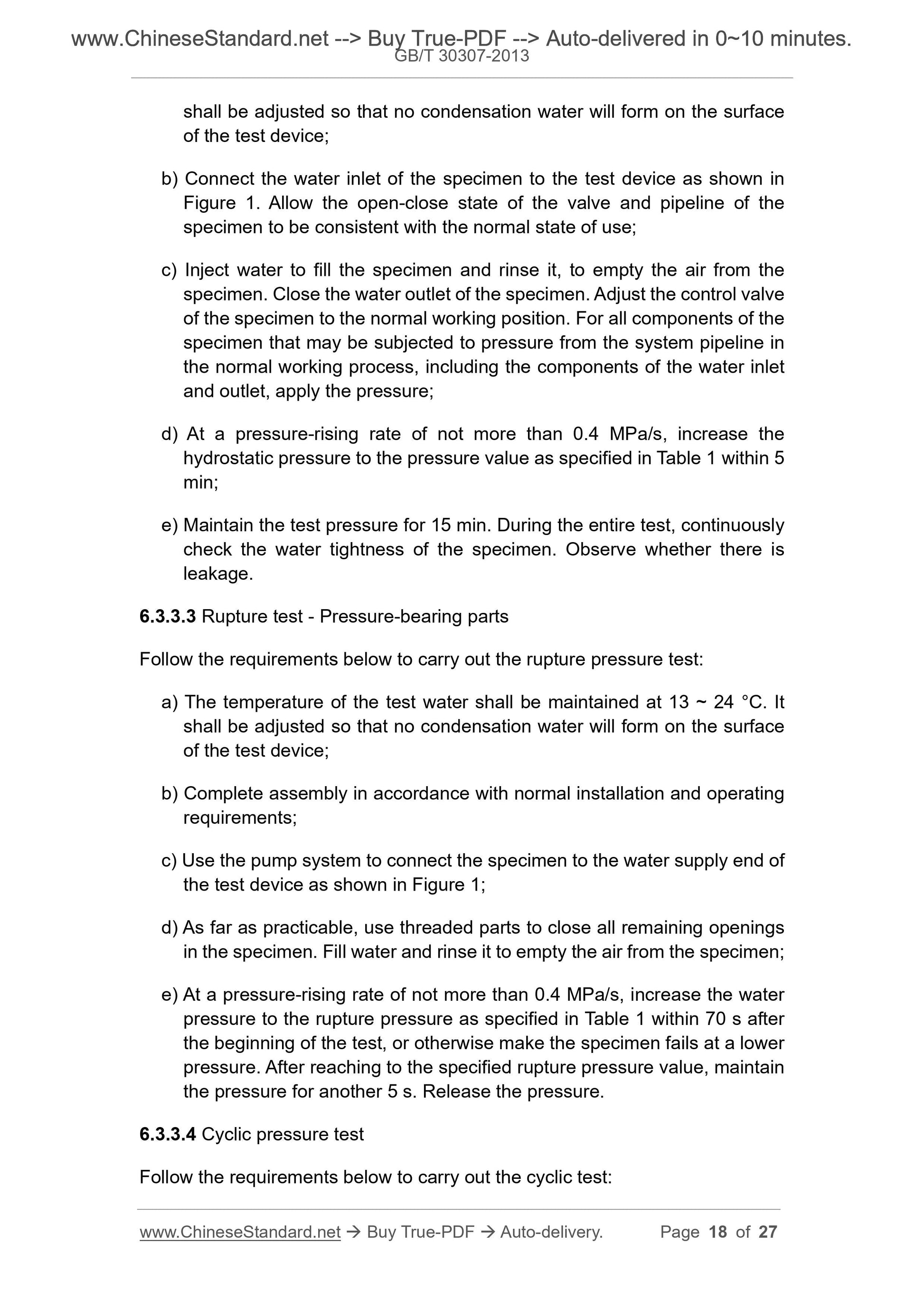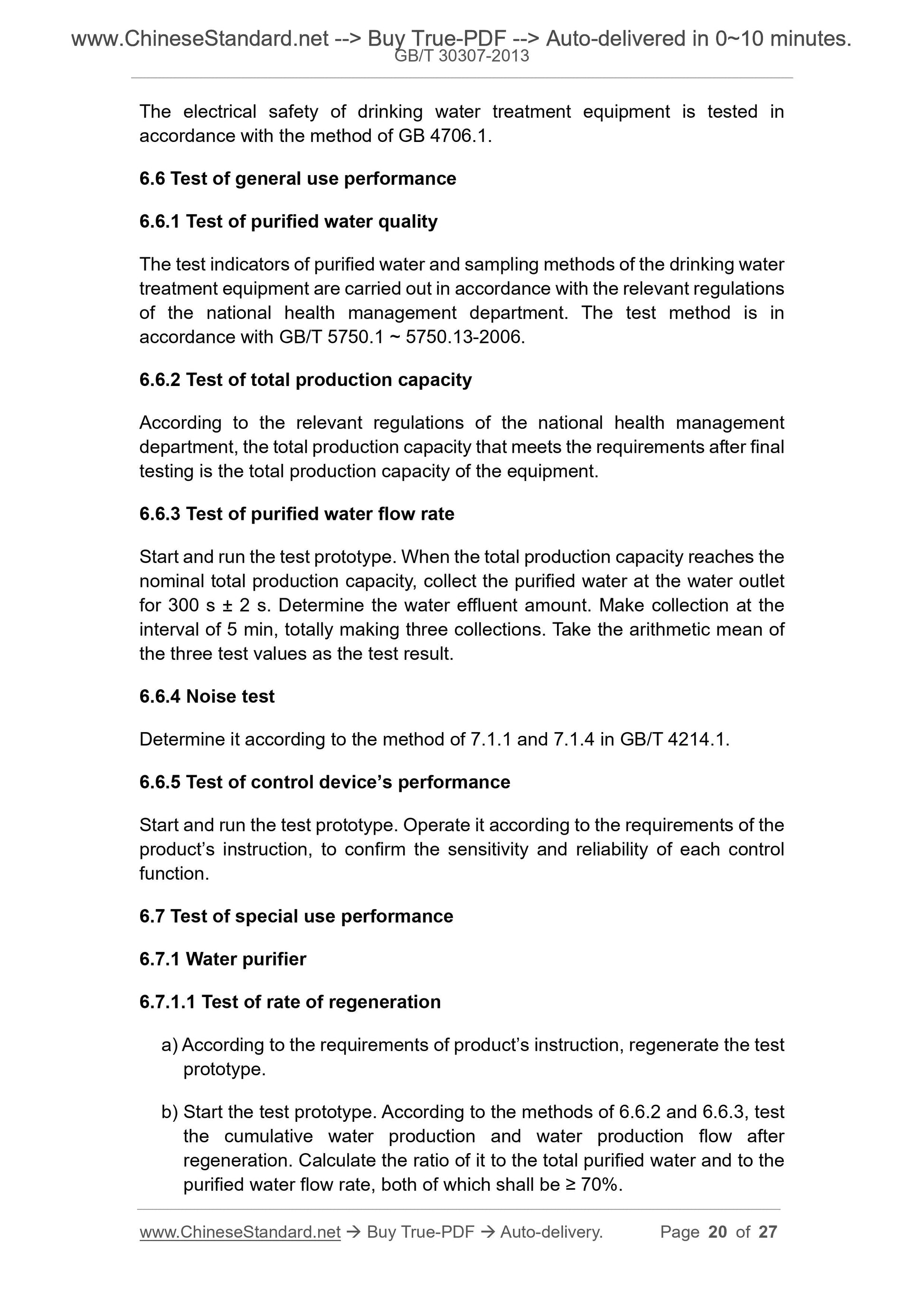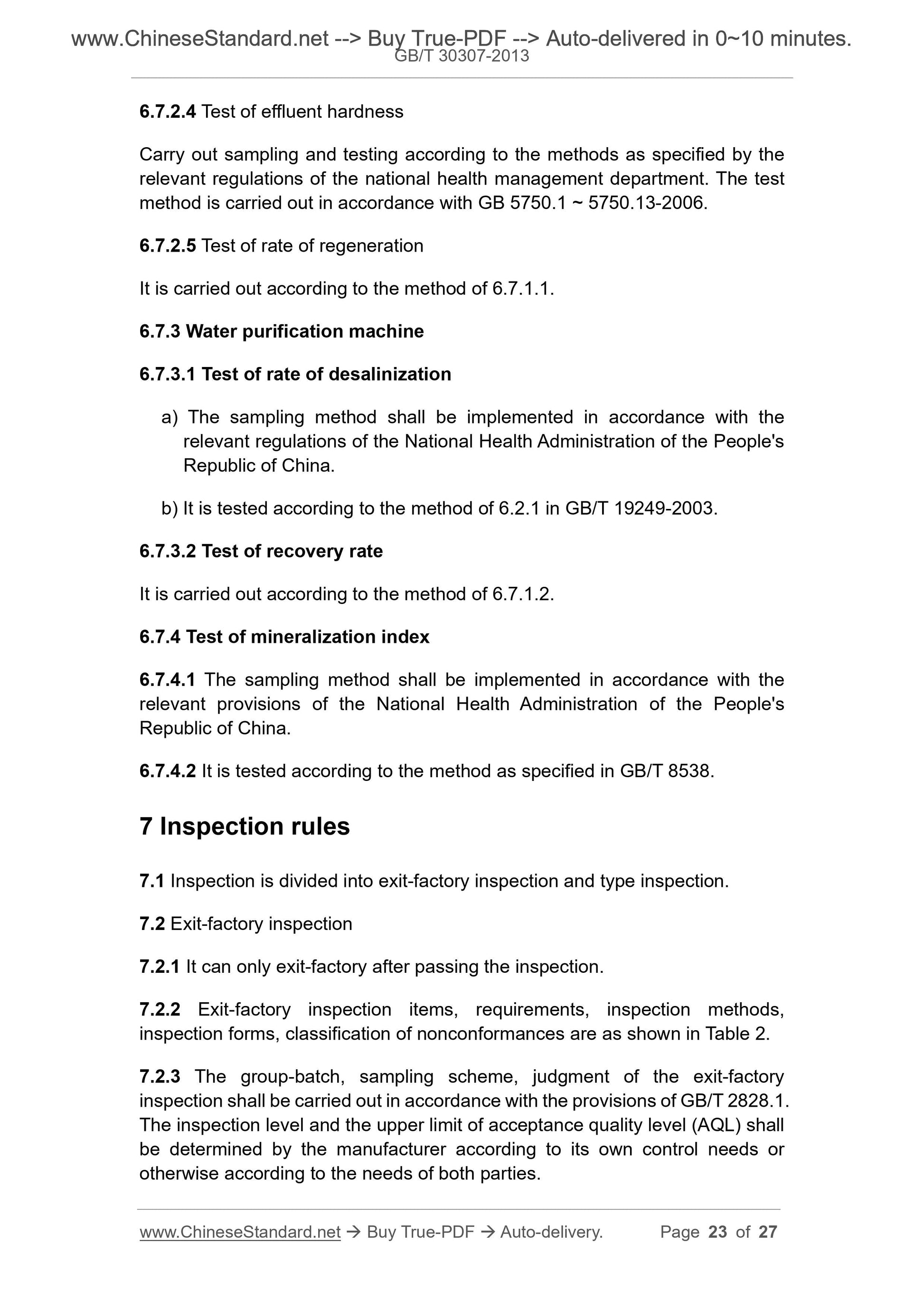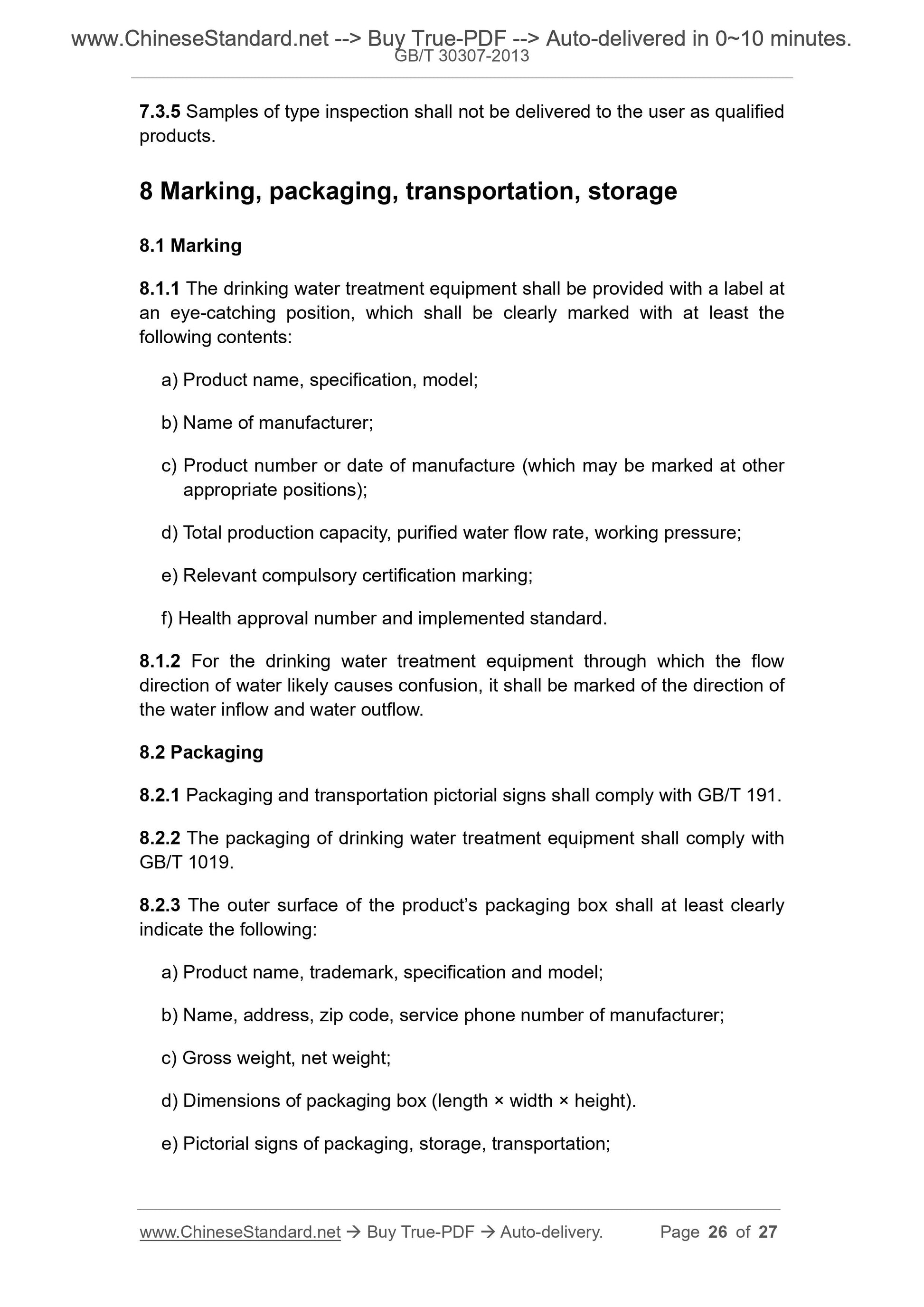1
/
of
12
PayPal, credit cards. Download editable-PDF and invoice in 1 second!
GB/T 30307-2013 English PDF (GBT30307-2013)
GB/T 30307-2013 English PDF (GBT30307-2013)
Regular price
$115.00 USD
Regular price
Sale price
$115.00 USD
Unit price
/
per
Shipping calculated at checkout.
Couldn't load pickup availability
Delivery: 3 seconds. Download true-PDF + Invoice.
Get QUOTATION in 1-minute: Click GB/T 30307-2013
Historical versions: GB/T 30307-2013
Preview True-PDF (Reload/Scroll if blank)
GB/T 30307-2013: Household and similar drinking water treatment equipment
GB/T 30307-2013
NATIONAL STANDARD OF THE
PEOPLE’S REPUBLIC OF CHINA
ICS 97.030
Y 60
Household and similar purposes
drinking water treatment equipment
ISSUED ON: DECEMBER 31, 2013
IMPLEMENTED ON: AUGUST 01, 2014
Issued by: General Administration of Quality Supervision, Inspection and
Quarantine of PRC;
Standardization Administration of PRC.
Table of Contents
Foreword ... 3
1 Scope ... 4
2 Normative references ... 4
3 Terms and definitions ... 5
4 Classification and naming ... 9
5 Technical requirements ... 10
6 Test methods ... 14
7 Inspection rules ... 23
8 Marking, packaging, transportation, storage ... 26
Household and similar purposes
drinking water treatment equipment
1 Scope
This standard specifies the terms and definitions, classification and naming,
technical requirements, test methods, inspection rules, marking, packaging,
transportation and storage of household and similar purposes drinking water
treatment equipment.
This standard applies to household and similar purposes drinking water
treatment equipment (hereinafter referred to as “drinking water treatment
equipment”).
2 Normative references
The following documents are essential to the application of this document. For
the dated documents, only the versions with the dates indicated are applicable
to this document; for the undated documents, only the latest version (including
all the amendments) are applicable to this standard.
GB/T 191 Packaging - Pictorial marking for handling of goods
GB/T 1019 General requirements for the package of household and similar
electrical appliances
GB/T 2828.1 Sampling procedures for inspection by attributes - Part 1:
Sampling schemes indexed by acceptance quality limit (AQL) for lot-by-lot
inspection
GB/T 2829 Sampling procedures and tables for periodic inspection by
attributes (Apply to inspection of process stability)
GB 4214.1 Acoustics - Household and similar electrical appliances - Test
code for determination of airborne acoustical noise - Part 1: General
requirements
GB 4706.1 Safety of household and similar electrical appliances - Part 1:
General requirements
GB 5749-2006 Standards for drinking water quality
Ultrafiltration
The physical screening process of using the pressure difference as a driving
force to separate a molecular weight which ranges from several hundred to
several millions at a membrane pore size of about 0.001 μm ~ 0.2 μm,
abbreviated as UF.
3.6
Nanofiltration
The membrane separation process of using pressure as the driving force to
remove the divalent or higher polyvalent ions as well as the organic matter
which has a molecular weight of 200 or more, abbreviated as NF.
3.7
Reverse osmosis
The process of applying an external pressure higher than the osmotic
pressure of the solution to the water inlet side of the membrane, which only
allows the water and some components in the solution to selectively
permeate, whilst the other substances are not permeable and are trapped
on the surface of the membrane, abbreviated as RO.
3.8
Mineralization
The process of adding one or several mineral components beneficial to the
human body to the water.
3.9
Ion exchange
The process of the chemical reaction of reversible exchange between the
ions present in the solution and the ion exchange solid medium, which has
no change to the solid structure, abbreviated as IE.
3.10
Electrodialysis
The process of using the ion exchange membrane as a separation medium,
the potential difference as a power, to cause the anion and cation in the
water to migrate at certain direction and pass through the ion exchange
membrane, thereby performing ion separation process, abbreviated as ED.
The ratio of the decrease in the amount of a substance in the influent to the
total content of the substance in the influent, expressed as a percentage.
3.19
Recovery
After purification, the ratio of purified water to total influent, which is
expressed as a percentage.
3.20
Rate of regeneration
Under the specified operating conditions, the ratio of the main functional
index to the those at the initial state of the water treatment unit after
regeneration, which is expressed as a percentage.
3.21
Purified water flow rate
Under the specified operating conditions, the amount of water produced per
nominal unit time of the manufacturer, expressed in liters per hour (L/h).
3.22
Total production capacity
Under the specified operating conditions, when the effluent quality of the
drinking water treatment equipment meets the requirements and the purified
water flow rate is not less than the nominal purified water flow rate, the
accumulated water production when any of the purification units are
regenerated or replaced, in liters (L)
3.23
Influent pressure
The water pressure at the water inlet of the drinking water treatment
equipment during operation, in megapascals (MPa).
3.24
Maximum working pressure
The maximum value of the working pressures as nominally used by the
manufacturer or the upper limit of the working pressure range, in
megapascals (MPa).
a) Municipal tap water or other centralized water supply;
b) Pressure: ≤ 0.4 MPa (gauge pressure);
c) Water temperature: 5 °C ~ 38 °C.
5.1.2 Power supply
Voltage: 187 V ~ 242 V;
Frequency: 50 Hz.
5.1.3 Environmental conditions
a) Temperature: 4 °C ~ 40 °C;
b) Relative humidity: ≤ 90% (at 25 °C).
5.2 Appearance requirements
5.2.1 The appearance of drinking water treatment equipment shall be clean,
tidy, free of rust.
5.2.2 The surface of the exposed structure of the drinking water treatment
equipment shall be flat and smooth, with uniform color and no sharp edges.
5.2.3 The surface of the coating of drinking water treatment equipment shall be
flat and bright; the color is uniform; the coating is firm. The surface shall not
have obvious defects such as flowing marks, scratches, wrinkles, pits, blistering,
holiday, collection of sand.
The decorative plating of the electroplated parts shall be smooth and fine, the
color shall be uniform. There shall be no defects such as spots, rust spots,
pinholes, blisters, peeling of plating.
The surface of the plastic parts shall be smooth and even; the color shall be
uniform. There shall be no defects such as cracks, blisters, obvious shrinkage
or deformation.
5.3 Structural requirements
5.3.1 Structural design shall consider easy maintenance or replacement of the
filter element.
5.3.2 The layout of the pipeline is reasonable; the connection is firm.
5.3.3 Drinking water treatment equipment (except for non-continuous treatment
equipment for drinking water) shall, when subjected to the hydrostatic pressure
test, rupture pressure test, cyclic pressure test as specified in Table 1, be free
5.6.2 Total production capacity
The total production capacity shall be greater than the nominal total production
capacity.
5.6.3 Purified water flow rate
a) The purified water flow rate of the non-continuous treatment equipment
for drinking water shall be not less than 2 L/h.
b) The purified water flow rate of the continuous treatment equipment for
drinking water shall be not less than 6 L/h.
c) The purified water flow rate shall not be lower than the nominal purified
water flow rate.
5.6.4 Noise
When the drinking water treatment equipment is operating norm...
Get QUOTATION in 1-minute: Click GB/T 30307-2013
Historical versions: GB/T 30307-2013
Preview True-PDF (Reload/Scroll if blank)
GB/T 30307-2013: Household and similar drinking water treatment equipment
GB/T 30307-2013
NATIONAL STANDARD OF THE
PEOPLE’S REPUBLIC OF CHINA
ICS 97.030
Y 60
Household and similar purposes
drinking water treatment equipment
ISSUED ON: DECEMBER 31, 2013
IMPLEMENTED ON: AUGUST 01, 2014
Issued by: General Administration of Quality Supervision, Inspection and
Quarantine of PRC;
Standardization Administration of PRC.
Table of Contents
Foreword ... 3
1 Scope ... 4
2 Normative references ... 4
3 Terms and definitions ... 5
4 Classification and naming ... 9
5 Technical requirements ... 10
6 Test methods ... 14
7 Inspection rules ... 23
8 Marking, packaging, transportation, storage ... 26
Household and similar purposes
drinking water treatment equipment
1 Scope
This standard specifies the terms and definitions, classification and naming,
technical requirements, test methods, inspection rules, marking, packaging,
transportation and storage of household and similar purposes drinking water
treatment equipment.
This standard applies to household and similar purposes drinking water
treatment equipment (hereinafter referred to as “drinking water treatment
equipment”).
2 Normative references
The following documents are essential to the application of this document. For
the dated documents, only the versions with the dates indicated are applicable
to this document; for the undated documents, only the latest version (including
all the amendments) are applicable to this standard.
GB/T 191 Packaging - Pictorial marking for handling of goods
GB/T 1019 General requirements for the package of household and similar
electrical appliances
GB/T 2828.1 Sampling procedures for inspection by attributes - Part 1:
Sampling schemes indexed by acceptance quality limit (AQL) for lot-by-lot
inspection
GB/T 2829 Sampling procedures and tables for periodic inspection by
attributes (Apply to inspection of process stability)
GB 4214.1 Acoustics - Household and similar electrical appliances - Test
code for determination of airborne acoustical noise - Part 1: General
requirements
GB 4706.1 Safety of household and similar electrical appliances - Part 1:
General requirements
GB 5749-2006 Standards for drinking water quality
Ultrafiltration
The physical screening process of using the pressure difference as a driving
force to separate a molecular weight which ranges from several hundred to
several millions at a membrane pore size of about 0.001 μm ~ 0.2 μm,
abbreviated as UF.
3.6
Nanofiltration
The membrane separation process of using pressure as the driving force to
remove the divalent or higher polyvalent ions as well as the organic matter
which has a molecular weight of 200 or more, abbreviated as NF.
3.7
Reverse osmosis
The process of applying an external pressure higher than the osmotic
pressure of the solution to the water inlet side of the membrane, which only
allows the water and some components in the solution to selectively
permeate, whilst the other substances are not permeable and are trapped
on the surface of the membrane, abbreviated as RO.
3.8
Mineralization
The process of adding one or several mineral components beneficial to the
human body to the water.
3.9
Ion exchange
The process of the chemical reaction of reversible exchange between the
ions present in the solution and the ion exchange solid medium, which has
no change to the solid structure, abbreviated as IE.
3.10
Electrodialysis
The process of using the ion exchange membrane as a separation medium,
the potential difference as a power, to cause the anion and cation in the
water to migrate at certain direction and pass through the ion exchange
membrane, thereby performing ion separation process, abbreviated as ED.
The ratio of the decrease in the amount of a substance in the influent to the
total content of the substance in the influent, expressed as a percentage.
3.19
Recovery
After purification, the ratio of purified water to total influent, which is
expressed as a percentage.
3.20
Rate of regeneration
Under the specified operating conditions, the ratio of the main functional
index to the those at the initial state of the water treatment unit after
regeneration, which is expressed as a percentage.
3.21
Purified water flow rate
Under the specified operating conditions, the amount of water produced per
nominal unit time of the manufacturer, expressed in liters per hour (L/h).
3.22
Total production capacity
Under the specified operating conditions, when the effluent quality of the
drinking water treatment equipment meets the requirements and the purified
water flow rate is not less than the nominal purified water flow rate, the
accumulated water production when any of the purification units are
regenerated or replaced, in liters (L)
3.23
Influent pressure
The water pressure at the water inlet of the drinking water treatment
equipment during operation, in megapascals (MPa).
3.24
Maximum working pressure
The maximum value of the working pressures as nominally used by the
manufacturer or the upper limit of the working pressure range, in
megapascals (MPa).
a) Municipal tap water or other centralized water supply;
b) Pressure: ≤ 0.4 MPa (gauge pressure);
c) Water temperature: 5 °C ~ 38 °C.
5.1.2 Power supply
Voltage: 187 V ~ 242 V;
Frequency: 50 Hz.
5.1.3 Environmental conditions
a) Temperature: 4 °C ~ 40 °C;
b) Relative humidity: ≤ 90% (at 25 °C).
5.2 Appearance requirements
5.2.1 The appearance of drinking water treatment equipment shall be clean,
tidy, free of rust.
5.2.2 The surface of the exposed structure of the drinking water treatment
equipment shall be flat and smooth, with uniform color and no sharp edges.
5.2.3 The surface of the coating of drinking water treatment equipment shall be
flat and bright; the color is uniform; the coating is firm. The surface shall not
have obvious defects such as flowing marks, scratches, wrinkles, pits, blistering,
holiday, collection of sand.
The decorative plating of the electroplated parts shall be smooth and fine, the
color shall be uniform. There shall be no defects such as spots, rust spots,
pinholes, blisters, peeling of plating.
The surface of the plastic parts shall be smooth and even; the color shall be
uniform. There shall be no defects such as cracks, blisters, obvious shrinkage
or deformation.
5.3 Structural requirements
5.3.1 Structural design shall consider easy maintenance or replacement of the
filter element.
5.3.2 The layout of the pipeline is reasonable; the connection is firm.
5.3.3 Drinking water treatment equipment (except for non-continuous treatment
equipment for drinking water) shall, when subjected to the hydrostatic pressure
test, rupture pressure test, cyclic pressure test as specified in Table 1, be free
5.6.2 Total production capacity
The total production capacity shall be greater than the nominal total production
capacity.
5.6.3 Purified water flow rate
a) The purified water flow rate of the non-continuous treatment equipment
for drinking water shall be not less than 2 L/h.
b) The purified water flow rate of the continuous treatment equipment for
drinking water shall be not less than 6 L/h.
c) The purified water flow rate shall not be lower than the nominal purified
water flow rate.
5.6.4 Noise
When the drinking water treatment equipment is operating norm...
Share
